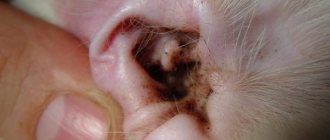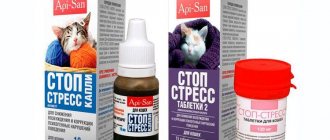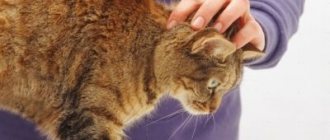What is an ear mite
Ear mites are microscopic ectoparasites. Adult individuals have a body length of 0.3-0.6 mm, so it is impossible to examine them without a microscope. They live in your pet's ear. At first, mites infect its outer part (outer ear), but gradually penetrate deeper and deeper.
The parasite has a claw-shaped mouthparts with which it pierces the skin. The parasite feeds on lymph and tissue fluid protruding to the surface.
Otodectosis can be recognized by the following signs:
- a cloying and unpleasant odor appears from one or both ears;
- a brown and loose coating appears inside the ear, under which ulcers and wounds form;
- the cat tilts its head towards the sore ear and scratches it;
- If an animal is severely infested with ticks, its hearing may deteriorate.
Without treatment, the disease progresses. The tick penetrates deeper into the animal's ear, infects its inner part, and then inflammation of the meninges occurs. In this case, the pet’s temperature rises, and seizures similar to epileptic seizures may begin.
Behavior of a cat when affected by ear mites
The disease can be detected in a pet by characteristic signs , since insects affect both ears at the same time.
Provoking factors for their spread are moisture and heat. When the ear canal is damaged, an inflammatory process occurs, which contributes to the abundant release of pus. This causes serious discomfort to the pet, and the unpleasant sensations are constantly annoying.
To identify the disease, it is enough to observe the cat’s behavior and check the ears for the presence of waste products of the parasite.
Characteristic signs of the disease affecting behavior:
- the cat becomes restless and cannot lie in one place;
- periodically shakes his head, meows pitifully;
- clings to the owner, tilting his head to the side;
- periodically scratches his ears on corners and furniture.
Infection can also be detected by the presence of purulent discharge that accumulates in the auricle, and by characteristic brown crusts directly in or near the ear.
Infection can also be detected by the presence of purulent discharge.
Lack of treatment leads to the penetration of the pathological process into the middle and inner ear, then the disease switches to the lining of the brain, which threatens serious health complications.
Symptoms of an advanced form of otodectosis:
- elevated temperature;
- dejected state;
- the head is constantly tilted towards the affected ear;
- periodic seizures.
An advanced form of the disease can cause death, so it is necessary to check the animal’s ears and respond in a timely manner to the unusual behavior of your pet.
Review of popular drugs for ear mites
Drops intended to kill ear parasites are divided into two types: some are instilled into the ears of cats, and others are applied to the pet’s withers.
The first drugs include:
- Bars (dimpylate and diazinon). This drug is bottled in glass bottles of 10 and 5 ml, or plastic bottles (30, 20, 15, 10 and 5 ml). For cats, the medicine is instilled into both ears, 2-3 drops. The course of treatment is two treatments with a break of 7 days.
- Surolan (prednisolone, polymyxin and miconazole). The drug has the form of a thick transparent suspension. Available in plastic bottles of 15 or 30 ml. Surolan effectively fights not only ear parasites, but also other diseases caused by fungi and bacteria (otitis media, dermatitis, etc.). The suspension is instilled into each ear, 3-4 drops, for 2 weeks.
- Oricin (ivermectin). The drug goes on sale in plastic bottles containing 25 ml of solution. Each bottle has a convenient dropper spout. For mild infection, treatment lasts 3-4 days. If the damage is severe, the course is extended to 7 days. 2 drops are dripped into each ear of the pet.
- Amitrazine (amitraz). An oily, yellow medicine with a pungent odor. It goes on sale in white plastic bottles of 20, 15 and 10 ml. 2-3 drops of medicine are instilled into the cat's ears. The course of treatment is 3-6 treatments with an interval of 3 days.
- Otoferonol. Available in three varieties: Plus (cycloferon and deltamethrin), Gold (cycloferon, deltamethrin and propolis extract) and Premium (permethrin). Dosage for cats: 2-3 drops in each ear. The course of treatment consists of two treatments, the interval between them is 7 days.
- Aurican (tetracaine, diazinon, prednisolone and hexamidine). Drops are poured into 20 ml bottles. The treatment regimen is as follows: the first 7 days - daily treatment with 4-5 drops in each ear, then treatment is carried out twice a week for 30 days.
Names and descriptions of drugs that are applied to the withers:
- Stronghold (selamectin). The medicine is packaged in small sealed pipettes. For cats, the dosage of selamectin is 45 mg (0.75 ml pipettes). Stronghold is applied to the pet’s withers once.
- Advocate (imidacloprid and moxidectin). The drops are sold in sealed pipettes. For cats, two dosages are available: for pets from 1.5 to 4 kg, and for large animals from 4 to 8 kg.
REFERENCE! You can fight ear mites not only with drops. Pet stores offer ointments, injection solutions and sprays that help rid your pet of parasites.
Criteria for choosing ear drops for cats
Otodectosis is a rather unpleasant disease for animals that causes discomfort. Anti-tick drops for cats are rightfully considered the most effective treatment method.
Among the wide list of drugs provided by the pharmacological market, it is quite difficult to choose an effective remedy. To make the right choice, you need to pay attention to several characteristics of ear mite drops:
- Mechanism of action. Exactly how the ticks will be affected depends on the main active ingredient in the drops. Some cause paralysis and death of mites, others stop the development of eggs and larvae hatching from them, thereby preventing the scenario where ear mites in cats may appear again.
- Contraindications. If the disease is in an advanced stage, there are open wounds on the ears or the eardrum has been damaged, treatment with drops is impossible. You also need to remember that pregnant and lactating females need delicate care, which means milder medications.
If necessary, you can first treat diseases that interfere with the use of drops, and only then deal with ticks.
Rules for the use of drugs
Treating a cat for ear parasites requires preliminary preparation. Before the procedure, it is necessary to heat the medicine to a temperature of 25-27 degrees. You should also prepare equipment: cotton pads, bandages or gauze, a solution for cleaning the inside of the ear.
The procedure is carried out as follows:
- The cat is calmed and restrained well. To do this, you can use a durable bag, carrier or thick blanket.
- The cat's ears need to be cleaned of brown deposits. To do this, a special lotion or saline solution is instilled into each ear, the auricle is folded in half and gently massaged. After this, the soaked plaque is removed with a clean cotton pad.
- The amount of the drug indicated in the instructions is instilled into each ear of the cat.
- After applying the drops, the base of the ear is folded and gently massaged so that the medicine is evenly distributed over the surface.
- After treatment, the animal is released. After this, the cat actively shakes its head, and excess drug is removed from the ear.
IMPORTANT! Many cats behave very aggressively during ear treatment, so it is necessary to securely restrain the pet.
Names, descriptions and characteristics of the top 5 remedies for ear mites
The following products have proven themselves to be the most effective and fastest-acting, which significantly sets them apart from the rest.
Means "Bars"
It is sold in 20 ml packs. Cost - about 150 rubles. Contains diazinon and prednisolone. This combination of substances has a detrimental effect on insects, destroying both adults and larvae. “Bars” relieves inflammation, swelling, eliminates itching, and promotes wound healing.
Contraindications are individual intolerance to any of the components present in the composition, and perforation of the eardrum. Ignoring the dosage will negatively affect your pet’s well-being.
"Amitrazine Plus"
The drug is sold in 10 ml packages, its cost is 75-85 rubles. Active ingredients: amitraz, decamethoxin.
The combination of these substances has an inhibitory effect on adult ticks and larvae, has an antifungal and bactericidal effect, relieves inflammation and neutralizes possible infection.
The medicine quickly penetrates the skin, the effect is noticeable after just 1 treatment. The duration of therapy is 6-8 days. The only contraindication for use is individual intolerance.
Effective medicine "Otoferonol Gold"
Release form: drops, packaged in 10 ml. The cost of packaging is 150 rubles.
Main active ingredients:
- deltamethrin is a synthetic pyrethroid, the action of which is aimed at blocking the nerve impulses of the insect, resulting in paralysis and then death;
- cycloferon - an anti-inflammatory component that eliminates infection, swelling, itching;
- propolis extract – a substance that accelerates wound healing.
Otoferonol Gold, thanks to its complex effects, improves the pet’s well-being after the first procedure.
"Otoferonol Gold"
Contraindications for use:
- age less than 2 months;
- pregnancy;
- concomitant infectious diseases;
- feeding kittens;
- perforation of the eardrum;
- individual intolerance.
Drops "Tsipam"
They are packaged in dropper bottles with a volume of 20 ml and cost 150-160 rubles. The active ingredients are cypermethrin and amitraz. The drug quickly accumulates in a toxic concentration in the body of the parasite, which leads to its rapid death.
Drops "Tsipam"
To combat the parasite, it is recommended to carry out treatment 2 times every 3-5 days according to the instructions. Instill 3-6 drops depending on the size of the pet.
Contraindications:
- pregnancy;
- feeding period;
- less than 6 weeks old;
- concomitant infectious pathologies.
The medicine is sold in a dosage of 20 ml, the cost per package reaches 120-150 rubles. The active component is amitraz, which has an inhibitory effect on parasites.
Excipients ensure deep penetration into the skin and rapid action. "Amit" relieves inflammation and itching, accelerates healing.
Treatment should be carried out according to the instructions until the unpleasant symptoms are completely eliminated, once every 5 days.
Contraindications for use:
- concomitant infections in the body;
- weakened immune system;
- period of pregnancy, feeding;
- less than 8 weeks old.
Contraindications, side effects and precautions
Most anti-ear mite medications have an age limit. Small kittens under 2 months of age should not be treated. It is also not recommended to treat weakened animals with drops.
Possible side effects include the development of an allergic reaction. It is rarely observed, and in this case the pet should be taken to a veterinarian.
Before treating your cat with drops, you must put on medical latex gloves. If the medicine gets on the skin, wash it well with soapy water. Drop containers are disposed of with household waste.
Ear drops for cats
Amit
Amit is used to combat parasites in cats. It is not absorbed into the skin, but acts on the affected area.
The drug is prescribed for diseases such as:
- otodecosis;
- demodicosis;
- notoedrosis;
- sarcoptic mange.
Good to know! Amit is a low-toxic drug. If the instructions are followed, it does not cause irritation, does not affect the functioning of the animal’s body, and has no embryotoxic properties.
Anandin plus
Anandin is most often prescribed for the treatment of ear scabies.
Signs of this disease include:
- Itching.
- Discharge from the ears.
- Animal anxiety.
Good to know! Anandin helps fight the cause of the disease and also fights the consequences. The drug contains various components, including bactericidal and anti-inflammatory, which eliminate itching, irritation and prevent the recurrence of the disease.
Aurikan
Aurican has many properties, including:
- acaricidal;
- antibacterial;
- local anesthetic effect.
Note! Aurican is used for various ear diseases in cats and dogs, including bacterial infections.
Leopard
The action of Bars is aimed at destroying various parasites. The composition includes diflubenzuron, this component acts on parasite eggs, stops the reproduction process, as a result, the parasite population does not increase, but declines.
The drug is applied to the affected areas, the active substances are not absorbed into the blood, but are distributed throughout the body, further protecting the animal from parasites. The drug Bars is well suited for cats and dogs and is easily tolerated when taking the prescribed dose.
Otibiovet
Otibiovet is characterized by a wide spectrum of action.
The main active ingredient is Triamcinolone acetonide, it has the following actions:
- relieves inflammation;
- antiallergic;
- reduces swelling
Note! Salicylic acid helps heal wounds and relieve inflammation. Otibiovet is prescribed to cats and dogs to treat bacterial and fungal infections of the ear canal.
Otidez
Otidesis is effective in treating various manifestations of otitis media that are caused by bacterial and fungal infections. Helps fight parasites, relieve allergies, and also heal wounds, relieve dermatitis of the ear canal.
Otoferonol
- It comes in the form of drops and has an anti-inflammatory effect.
- Recommended for the prevention of ear scabies in dogs and cats.
- Actively removes ticks.
- The action of the drug is based on blocking the vital activity and reproduction of parasites.
Surolan
- Surolan is used to treat otitis media in dogs and cats, as well as various bacterial and fungal infections.
- The drug is available in the form of a clear liquid and has a slight specific odor.
- When using the drug according to the instructions, Surolan does not cause complications or negative effects on the animal’s body.
Tsipam
- It is used to treat ear scabies, psoroptosis, sarcoptic mange, notoedrosoma and demodicosis.
- Excellent fight against fleas.
- Used to eliminate ixodid ticks.
How to remove ear mites from a cat?
Anyone who has not encountered ear mites in animals usually associates them with a large insect that sticks to the skin and which only needs to be twisted in a certain direction for it to come off. But with this ear mite, everything goes completely differently. It is not twisted, but washed.
– It is impossible to remove ear mites. It's microscopic. It is impossible to see it with the naked eye, therefore, it will not be possible to pull it out with your fingers or any other object,” says , veterinarian at the Mukhtar VK, Krasnoyarsk .











